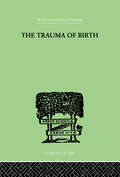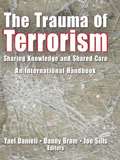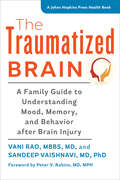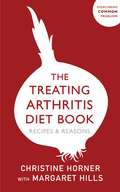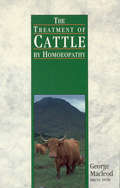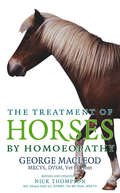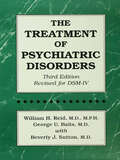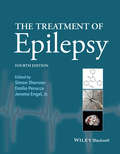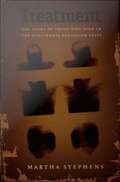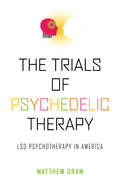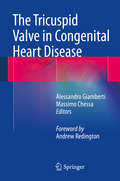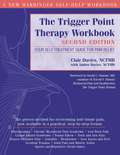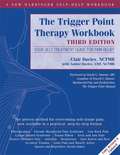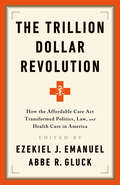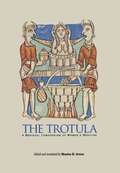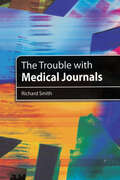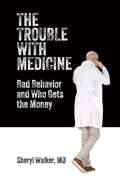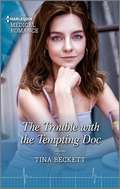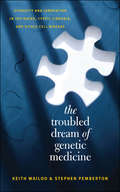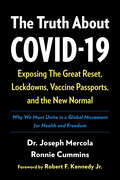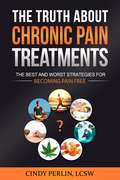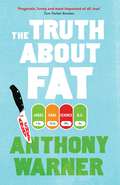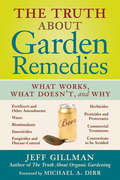- Table View
- List View
The Trauma Of Birth (International Library Of Psychology Ser.)
by Rank, OttoFirst Published in 1999. This text outlines developments in psycho-analysis, from the consistent application of the method created by Freud and from the dotrine based on the method. The authors seek to gain a general and wider knowledge of the Unconscious.
The Trauma of Terrorism: Sharing Knowledge and Shared Care, An International Handbook
by Yael DanieliLearn intervention strategies to counter the effects of terrorismIn the twenty-first century, terrorism has become an international scourge whose effect devastates individuals, weakens societies, and cripples nations. The Trauma of Terrorism: Sharing Knowledge and Shared Care, An International Handbook and Shared Care provides a compreh
The Traumatized Brain: A Family Guide to Understanding Mood, Memory, and Behavior after Brain Injury (A Johns Hopkins Press Health Book)
by Vani Rao Sandeep VaishnaviUseful information and real hope for patients and families whose lives have been altered by traumatic brain injury.A traumatic brain injury is a life-changing event, affecting an individual’s lifestyle, ability to work, relationships—even personality. Whatever caused it—car crash, work accident, sports injury, domestic violence, combat—a severe blow to the head results in acute and, often, lasting symptoms. People with brain injury benefit from understanding, patience, and assistance in recovering their bearings and functioning to their full abilities.In The Traumatized Brain, neuropsychiatrists Drs. Vani Rao and Sandeep Vaishnavi—experts in helping people heal after head trauma—explain how traumatic brain injury, whether mild, moderate, or severe, affects the brain. They advise readers on how emotional symptoms such as depression, anxiety, mania, and apathy can be treated; how behavioral symptoms such as psychosis, aggression, impulsivity, and sleep disturbances can be addressed; and how cognitive functions like attention, memory, executive functioning, and language can be improved. They also discuss headaches, seizures, vision problems, and other neurological symptoms of traumatic brain injury. By stressing that symptoms are real and are directly related to the trauma, Rao and Vaishnavi hope to restore dignity to people with traumatic brain injury and encourage them to ask for help. Each chapter incorporates case studies and suggestions for appropriate medications, counseling, and other treatments and ends with targeted tips for coping. The book also includes a useful glossary, a list of resources, and suggestions for further reading.
The Treating Arthritis Diet Book: Recipes and Reasons
by Margaret Hills Christine HornerFOODS TO HELP AND HEAL ARTHRITIS - EAT BETTER, FEEL BETTERHundreds of thousands of people with arthritis have been helped by the Margaret Hills Clinic and by Margaret's bestselling book, Treating Arthritis: The Drug-free Way. This companion title, completely updated with all-new recipes, offers a full range of nutritional resources to bring about an improvement for anyone struggling with pain and mobility.Embracing the simple principles that make this drug-free protocol so effective, this book offers hundreds of recipes and dietary plans, as well as an overview of why diet is so important for managing arthritis. It caters for vegetarians and vegans, and has recommendations for those managing auto-immune conditions such as coeliac disease, or food allergies. There are clean, contemporary and delicious meals for every season, as well as such essentials as smoothies, juices, bone broth and healthful bread recipes. With an emphasis on fresh, raw, local ingredients, the recipes in this book complement the Treating Arthritis programme to offer gentle, natural and manageable steps to reduce pain and improve mobility.
The Treating Arthritis Diet Book: Recipes and Reasons
by Margaret Hills Christine HornerFOODS TO HELP AND HEAL ARTHRITIS - EAT BETTER, FEEL BETTERHundreds of thousands of people with arthritis have been helped by the Margaret Hills Clinic and by Margaret's bestselling book, Treating Arthritis: The Drug-free Way. This companion title, completely updated with all-new recipes, offers a full range of nutritional resources to bring about an improvement for anyone struggling with pain and mobility.Embracing the simple principles that make this drug-free protocol so effective, this book offers hundreds of recipes and dietary plans, as well as an overview of why diet is so important for managing arthritis. It caters for vegetarians and vegans, and has recommendations for those managing auto-immune conditions such as coeliac disease, or food allergies. There are clean, contemporary and delicious meals for every season, as well as such essentials as smoothies, juices, bone broth and healthful bread recipes. With an emphasis on fresh, raw, local ingredients, the recipes in this book complement the Treating Arthritis programme to offer gentle, natural and manageable steps to reduce pain and improve mobility.
The Treatment Of Cattle By Homoeopathy
by George MacleodMany farmers today are concerned, not only with the increasing cost of conventional drugs, but also with their side-effects and the build-up of resistant strains of bacteria due to the continued and often indiscriminate use of antibiotics.While this book will appeal to the already converted it is hoped that the unprejudiced newcomer will be sufficiently encouraged to investigate this system of medicine and enjoy its undoubted benefits.The aim of the homeopathic approach is to build up the health of the herd and increase the resistance of its individual members to disease, and, in consequence to increase the milk output and quality.Homeopathic remedies are all derived from natural sources and George Macleod outlines the homeopathic approach to the commoner diseases of cattle, omitting only serious injuries and others which are not economic to treat.
The Treatment Of Horses By Homoeopathy
by George MacleodThis book is for anyone who is interested in the welfare of horses, and who wishes to know more about treating them with homoeopathic remedies. Increasing numbers of horse owners and handlers today confirm that homoeopathy is a speedy and effective treatment, which can often deal with so-called 'incurable' ailments. As this fascinating guide explains, homoeopathic remedies are absolutely safe, easy to administer and have no side effects. This authoritative book includes advice on treating horses homoeopathically for both specific diseases and common ailments.
The Treatment Of Psychiatric Disorders
by William H. Reid George U. Balis Beverly J. SuttonThis is the third edition, revised for the DSM-IV, of the one volume, standard, comprehensive text on the treatment of psychiatric disorders - spanning the biological, psychological and psychosocial.; Updated and revised, this book is the result of several thousand studies, clinical reports, and reference works. Information is specifically coordinated with the DSM-IV, and the authors' discussion reflects what is currently known about standard treatments as well as many of the more esoteric therapies.
The Treatment of Epilepsy
by Simon D. Shorvon Emilio Perucca Jerome Engel Jr.The Treatment of Epilepsy, fourth edition, is a comprehensive reference and clinical guide to the pharmacological, medical and surgical options available in the treatment of epilepsy. The text is compiled by a group of internationally renowned editors and contributors and is now in full color and extensively illustrated The first two sections cover the background to, and principles of, treatment in different clinical situations Section three comprises a series of systematic reviews of contemporary drug therapy, devoting one chapter to each anti-epileptic drug and covering all clinically-relevant aspects Section four focuses on the surgical options, devoting individual chapters to each of the modalities of presurgical assessment and to each surgical operation or approach This 4th edition is extensively revised incorporating the many recent developments in therapy, and comprises 81 chapters from world experts from 18 countries
The Treatment: The Story of Those who Died in the Cincinnati Radiation Tests
by Martha StephensThe Treatment is the story of one tragedy of medical research that stretched over eleven years and affected the lives of hundreds of people in an Ohio city. Thirty years ago the author, then an assistant professor of English, acquired a large set of little-known medical papers at her university. These documents told a grotesque story. Cancer patients coming to the public hospital on her campus were being swept into secret experiments for the U. S. military; they were being irradiated over their whole bodies as if they were soldiers in nuclear war. Of the ninety women and men exposed to this treatment, twenty-one died within a month of their radiations. Martha Stephens's report on these deaths led to the halting of the tests, but local papers did not print her charges, and for many years people in Cincinnati had no way of knowing that lethal experiments had taken place there. In 1994 other military tests were brought to light, and a yellowed copy of Stephens's original report was delivered to a television newsroom. In Ohio, major publicity ensued--at long last--and reached around the world. Stephens uncovered the names of the victims, and a legal action was filed against thirteen researchers and their institutions. A federal judge compared the deeds of the doctors to the medical crimes of the Nazis during World War II and refused to dismiss the researchers from the suit. After many bitter disputes in court, they agreed to settle the case with the families of those they had afflicted. In 1999 a memorial plaque was raised in a yard of the hospital. Who were these doctors and why had they done as they did? Who were the people whose lives they took? Who was the reporter who could not forget the story, the young attorney who first developed the case, the judge who issued the historic ruling against the doctors? This is Stephens's moving account of all that transpired in these lives and her own during this epic battle between medicine and human rights.
The Trials of Psychedelic Therapy: LSD Psychotherapy in America
by Matthew OramThe rise—and fall—of research into the therapeutic potential of LSD.After LSD arrived in the United States in 1949, the drug's therapeutic promise quickly captured the interests of psychiatrists. In the decade that followed, modern psychopharmacology was born and research into the drug's perceptual and psychological effects boomed. By the early 1960s, psychiatrists focused on a particularly promising treatment known as psychedelic therapy: a single, carefully guided, high-dose LSD session coupled with brief but intensive psychotherapy. Researchers reported an astounding 50 percent success rate in treating chronic alcoholism, as well as substantial improvement in patients suffering from a range of other disorders. Yet despite this success, LSD officially remained an experimental drug only. Research into its effects, psychological and otherwise, dwindled before coming to a close in the 1970s. In The Trials of Psychedelic Therapy, Matthew Oram traces the early promise and eventual demise of LSD psychotherapy in the United States. While the common perception is that LSD's prohibition terminated legitimate research, Oram draws on files from the Food and Drug Administration and the personal papers of LSD researchers to reveal that the most significant issue was not the drug's illegality, but the persistent question of its efficacy. The landmark Kefauver-Harris Drug Amendments of 1962 installed strict standards for efficacy evaluation, which LSD researchers struggled to meet due to the unorthodox nature of their treatment.Exploring the complex interactions between clinical science, regulation, and therapeutics in American medicine, The Trials of Psychedelic Therapy explains how an age of empirical research and limited government oversight gave way to sophisticated controlled clinical trials and complex federal regulations. Analyzing the debates around how to understand and evaluate treatment efficacy, this book will appeal to anyone with an interest in LSD and psychedelics, as well as mental health professionals, regulators, and scholars of the history of psychiatry, psychotherapy, drug regulation, and pharmaceutical research and development.
The Tricuspid Valve in Congenital Heart Disease
by Alessandro Giamberti Massimo ChessaThis book is devoted solely to the tricuspid valve and its role in congenital heart disease. Tricuspid valve anomalies are part of the pathological spectrum in various congenital heart diseases, including Ebstein anomaly and tricuspid valve dysplasia, with different pathophysiology and clinical implications. This book covers all relevant aspects of such anomalies, including diagnosis, therapy and follow-up. Further topics addressed include the way in which the tricuspid valve may become the "systemic" valve in some congenital diseases, with important consequences and the involvement of the tricuspid valve in the right-sided heart complications often seen in adults with congenital heart disease. All of the chapters are written by internationally recognized experts and are designed to deliver state of the art knowledge of practical value. This book will be an important addition to the library for surgeons, cardiologists and other practitioners involved in the management of patients with congenital heart disease.
The Trigger Point Therapy Workbook: Your Self-Treatment Guide for Pain Relief (2nd edition)
by Clair Davies Amber DaviesThe Trigger Point Therapy Workbook, outlines a very user-friendly and completely up-to-date method of self-massage that people can employ as a means of reducing and curing their pain.
The Trigger Point Therapy Workbook: Your Self-Treatment Guide for Pain Relief (Third Edition)
by Clair Davies Amber DaviesTrigger point therapy is one of the fastest-growing and most effective pain therapies in the world. Medical doctors, chiropractors, physical therapists, and massage therapists are all beginning to use this technique to relieve patients’ formerly undiagnosable muscle and joint pain, both conditions that studies have shown to be the cause of nearly 25 percent of all doctor visits. This book addresses the problem of myofascial trigger points—tiny contraction knots that develop in a muscle when it is injured or overworked. Restricted circulation and lack of oxygen in these points cause referred pain. Massage of the trigger is the safest, most natural, and most effective form of pain therapy. Trigger points create pain throughout the body in predictable patterns characteristic to each muscle, producing discomfort ranging from mild to severe. Trigger point massage increases circulation and oxygenation in the area and often produces instant relief. The Trigger Point Therapy Workbook, Third Edition, has made a huge impact among health professionals and the public alike, becoming an overnight classic in the field of pain relief. This edition includes a new chapter by the now deceased author, Clair Davies’ daughter, Amber Davies, who is passionate about continuing her father’s legacy. The new edition also includes postural assessments and muscle tests, an illustrated index of symptoms, and clinical technique drawings and descriptions to assist both practitioners and regular readers in assessing and treating trigger points. If you have ever suffered from, or have treated someone who suffers from myofascial trigger point pain, this is a must-have book.
The Trillion Dollar Revolution: How the Affordable Care Act Transformed Politics, Law, and Health Care in America
by Ezekiel J Emanuel Abbe R. GluckTen years after the landmark legislation, Ezekiel Emanuel leads a crowd of experts, policy-makers, doctors, and scholars as they evaluate the Affordable Care Act's history so far.In March 2010, the Affordable Care Act officially became one of the seminal laws determining American health care. From day one, the law was challenged in court, making it to the Supreme Court four separate times. It transformed the way a three-trillion-dollar sector of the economy behaved and brought insurance to millions of people. It spawned the Tea Party, further polarized American politics, and affected the electoral fortunes of both parties.Ten years after the bill's passage, a constellation of experts--insiders and academics for and against the ACA--describe the momentousness of the legislation. Encompassing Democrats and Republicans, along with legal, financial, and health policy experts, the essays here offer a fascinating and revealing insight into the political fight of a generation, its consequences for health care, politics, law, the economy-and the future.
The Trojan Horse in the Belly of the Beast: A Novel of the Iran Nuclear Weapons Interdiction Project (Iran Nuclear Weapons Interdiction Project Ser. #3)
by Carl DouglassThe carefully crafted projects and deep secrets of the Islamic Republic of Iran and their opponents in the Iran Nuclear Weapons Interdiction Project each bring their best and their worst to fruition in this the final book in the Trojan Horse in the Belly of the Beast Trilogy. Both sides are playing an extremely expensive and dangerous game with apocalypse or economic ruin as real consequences. Cyber war is waged with a vengeance, but Afsoon and Gideon hold strategic advantages. The question is whether or not their elaborate plan will succeed in time to prevent the impending holocaust. The answer to that existential reality will depend upon whether or not Afsoon can survive.
The Trotula: A Medieval Compendium of Women's Medicine (The Middle Ages Series)
by Monica H. GreenThe Trotula was the most influential compendium on women's medicine in medieval Europe. Scholarly debate has long focused on the traditional attribution of the work to the mysterious Trotula, said to have been the first female professor of medicine in eleventh- or twelfth-century Salerno, just south of Naples, then the leading center of medical learning in Europe. Yet as Monica H. Green reveals in her introduction to this first edition of the Latin text since the sixteenth century, and the first English translation of the book ever based upon a medieval form of the text, the Trotula is not a single treatise but an ensemble of three independent works, each by a different author. To varying degrees, these three works reflect the synthesis of indigenous practices of southern Italians with the new theories, practices, and medicinal substances coming out of the Arabic world.Arguing that these texts can be understood only within the intellectual and social context that produced them, Green analyzes them against the background of historical gynecological literature as well as current knowledge about women's lives in twelfth-century southern Italy. She examines the history and composition of the three works and introduces the reader to the medical culture of medieval Salerno from which they emerged. Among her findings is that the second of the three texts, "On the Treatments for Women," does derive from the work of a Salernitan woman healer named Trota. However, the other two texts—"On the Conditions of Women" and "On Women's Cosmetics"—are probably of male authorship, a fact indicating the complex gender relations surrounding the production and use of knowledge about the female body.Through an exhaustive study of the extant manuscripts of the Trotula, Green presents a critical edition of the so-called standardized Trotula ensemble, a composite form of the texts that was produced in the mid-thirteenth century and circulated widely in learned circles. The facing-page complete English translation makes the work accessible to a broad audience of readers interested in medieval history, women's studies, and premodern systems of medical thought and practice.
The Trouble with Medical Journals
by Richard SmithIt is a turbulent time for STM publishing. With moves towards open access to scientific literature, the future of medical journals is uncertain and unpredictable. This is the only book of its kind to address this problematic issue.Richard Smith, a previous editor of the British Medical Journal for twenty five years and one of the most influential people within medical journals and medicine depicts a compelling picture of medical publishing. Drawn from the author's own extensive and unrivalled experience in medical publishing, Smith provides a refreshingly honest analysis of current and future trends in journal publishing including peer review, ethics in medical publishing, the influence of the pharmaceutical industry as well as that of the mass media, and the risk that money can cloud objectivity in publishing.Full of personal anecdotes and amusing tales, this is a book for everyone, from researcher to patient, author to publisher and editor to reader. The controversial and highly topical nature of this book, will make uncomfortable reading for publishers, researchers, funding bodies and pharmaceutical companies alike making this useful resource for anyone with an interest in medicine or medical journals.Topic covered include: Libel and medical journals; Patients and medical journals; Medical journals and the mass media; Medical journals and pharmaceutical companies: uneasy bedfellows; Editorial independence; misconduct; and accountability; Ethical support and accountability for journals; Peer review: a flawed process and Conflicts of interest: how money clouds objectivity.This is a unique offering by the former BMJ editor- challenging, comprehensive and controversial. This must be the most controversial medical book of the 21st Century John Illman, MJA NewsLively, full of anecdote and he [Smith] is brutally honest British Journal of Hospital Medicine*************************************************************************************************Please note that the reference to Arup Banerjee on page 100 of this book should be to Anjan Banerjee. We apologise to Professor Arup Banerjee for this oversight.*************************************************************************************************
The Trouble with Medicine: Bad Behavior and Who Gets the Money
by Sheryl WalkerThis is the autobiographical journey of a female anesthesiologist in the American healthcare system where greed and lust for more is controlling everything we do. Are you tired, frustrated, and angry with the healthcare industry? Do you feel li
The Trouble with the Tempting Doc: Consequences Of Their New York Night (new York Bachelors' Club) / The Trouble With The Tempting Doc (new York Bachelors' Club) (New York Bachelors' Club #2)
by Tina BeckettHe&’s trouble with a capital T!Can she walk away?Starting a new job is never easy. But for Dr. Kirsten, the hardest part is cracking the enigma that is Snowden—the surgeon she&’ll be working very closely with! Kirsten can&’t help but ask how he can he be so standoffish…yet so irresistible. Still, Snowden is clear: a fling is all he can offer. Can Kirsten say yes and still protect her heart?A New York Bachelors&’ Club novel New York Bachelors&’ Club duetBook 1 - Consequences of Their New York NightBook 2 – The Trouble with the Tempting Doc &“Tina Beckett definitely followed through on the premise and managed to infuse just the right amount of angst and passion to keep me glued to the pages of Miracle Baby for the Midwife from beginning to end.&”-Harlequin Junkie&“This story is Ms. Beckett at her best. Really, it&’s a charming and delightful story…. Overall, Ms. Beckett has delivered a heart-warming tale in this book…where the chemistry between this couple was strong right the moment they come face-to-face for the first time in years; the romance was delightful and well worth the wait….&”-Harlequin Junkie on A Christmas Kiss with Her Ex-Army Doc
The Troubled Dream of Genetic Medicine: Ethnicity and Innovation in Tay-Sachs, Cystic Fibrosis, and Sickle Cell Disease
by Keith Wailoo Stephen PembertonWinner of the History of Science category of the Professional and Scholarly Publishing Awards given by the Association of American PublishersWhy do racial and ethnic controversies become attached, as they often do, to discussions of modern genetics? How do theories about genetic difference become entangled with political debates about cultural and group differences in America? Such issues are a conspicuous part of the histories of three hereditary diseases: Tay-Sachs, commonly identified with Jewish Americans; cystic fibrosis, often labeled a "Caucasian" disease; and sickle cell disease, widely associated with African Americans. In this captivating account, historians Keith Wailoo and Stephen Pemberton reveal how these diseases—fraught with ethnic and racial meanings for many Americans—became objects of biological fascination and crucibles of social debate. Peering behind the headlines of breakthrough treatments and coming cures, they tell a complex story: about different kinds of suffering and faith, about unequal access to the promises and perils of modern medicine, and about how Americans consume innovation and how they come to believe in, or resist, the notion of imminent medical breakthroughs. With Tay-Sachs, cystic fibrosis, and sickle cell disease as a powerful backdrop, the authors provide a glimpse into a diverse America where racial ideologies, cultural politics, and conflicting beliefs about the power of genetics shape disparate health care expectations and experiences.
The Truth About COVID-19: Exposing The Great Reset, Lockdowns, Vaccine Passports, and the New Normal
by Joseph Mercola Ronnie CumminsUSA Today, Wall Street Journal, and Publishers Weekly National Bestseller&“An eloquent, charismatic, and knowledgeable [critique] of a corrupt system.&”—Robert F. Kennedy, Jr., from the foreword&“Dr. Mercola is a visionary, pioneer, and leader.&”—Del Bigtree, host of The HighwireMultiple New York Times best-selling author Dr. Joseph Mercola and Ronnie Cummins, founder and director of the Organic Consumers Association, team up to expose the truth—and end the madness—about COVID-19.Through vigorous research, over 500 references to peer-reviewed scientific journal articles, official government statistics, and public health research findings from around the world, the authors lay bare the urgent need for a global awakening. It is time to come together, demand the truth, and take control of our health. The Truth About COVID-19 is your invitation to join Dr. Mercola and Cummins as they educate and organize for a healthy, equitable, democratic, and regenerative future.*The Paperback Edition is Updated with a New Preface by Dr. Mercola*&“Phenomenal . . . required reading for this time in our lives.&”—Shawn Stevenson, host of The Model Health Show&“Dr. Mercola has changed the way we think about health.&”—Dave Asprey, New York Times bestselling author and host of Bulletproof Radio
The Truth About Chronic Pain Treatments: The Best And Worst Strategies For Becoming Pain Free
by Cindy PerlinTHE ULTIMATE GUIDE TO BECOMING PAIN FREE If you're in chronic pain and you're not getting adequate relief from your treatment, this book is for you. You don't have to "learn to live with your pain" or put up with unpleasant side effects from your medication. There are treatments available that could safely cure your pain. The Truth About Chronic Pain Treatments reviews the evidence for the safety and effectiveness of a wide variety of treatments and reveals how organized medicine is keeping you from getting the care you need and deserve. It's a comprehensive guide to avoiding the treatments that don't work or are likely to cause harm and selecting the therapies that are most likely to promote healing. Here are some things you will learn about in The Truth About Chronic Pain Treatments -Prescription opioids like hydrocodone and oxycodone are highly addictive, even for medical patients taking them as directed. -Pain patients who take opioids have more pain, more disability and lower quality of life than similar patients who don't take opioids. -Nonsteroidal anti-inflammatory drugs like ibuprofen and Celebrex significantly raise your risk of heart attack, stroke and kidney damage. -So many people have abnormal findings on MRIs even when they don't have any pain that if you have herniated, bulging or degenerated disks, chances are that it has nothing to do with your pain. -Spinal fusion surgery fails about 50% of the time. -The more types of childhood trauma you have had, the more likely that back surgery will fail. -Psychological factors, including chronic stress, emotional repression and unresolved trauma, are frequent causes of pain and barriers to healing. -Mind/body treatments including relaxation training, biofeedback and psychotherapy can in many cases eliminate pain. -Chiropractic treatment is considered highly effective for back and neck pain by the World Health Organization and many governments around the world, including the U. S. government. -The chance of a serious adverse event from a low back chiropractic adjustment is just 1 in 100 million. -Low Level Laser Therapy, a little known treatment, has over 400 randomized controlled studies demonstrating its effectiveness for a wide variety of pain conditions, including back and neck pain, diabetic neuropathy, post herpetic neuralgia (shingles pain), post-surgical pain and wound healing, yet all insurances refuse to cover it because it is "experimental. " -What you eat can have a major impact on your pain levels. -Nutritional supplements, including vitamin D, magnesium and omega 3 fatty acids can have very potent pain relieving effects. -Marijuana is a powerful pain reliever which is also protective against cancer. -No one has ever died from a marijuana overdose. In The Truth About Chronic Pain Treatments you will also learn about the power of the following additional therapies to heal your pain: -Physical therapy -Exercise -Massage -Acupuncture -Herbs -Homeopathy -Energy medicine -Multidisciplinary pain treatment programs. Unlike most books on chronic pain treatment that advocate one specific treatment, The Truth About Chronic Pain Treatments provides information about a wide variety of treatments so that you can make informed decisions about the best treatments for you. The Truth About Chronic Pain Treatments also explains why you haven't heard more about the many safe, effective pain treatments that are available. It includes a legislative proposal, the Pain Treatment Parity Act, which would eliminate the barriers to pain patients getting safer and more effective care. This is a book that will change your life for the better.
The Truth About Fat: Why Obesity is Not that Simple
by Anthony WarnerMost people try out diets just to see if they work. One friend cuts out sugar, a second cuts out fat. Another mumbles something about gut microbes. Even scientists still seem to be arguing about what causes obesity, so what hope is there for the rest of us? Anthony Warner, author of The Angry Chef, has decided to get to the bottom of it once and for all. Is obesity really an epidemic? Can you be addicted to food? Can&’t you just exercise your way to freedom? And what the heck is a food desert? You want the truth? The science, without the prejudice? You can handle it.
The Truth About Garden Remedies: What Works, What Doesn't & Why
by Jeff GillmanCan beer make plants grow? How about buttermilk? Or music—classical or rock? Are you sure about planting trees in deep holes? And how about chasing insects with hot sauce and stopping slugs with eggshells? Whether in ancient books, on television, or in gardening publications, remedies for all your garden woes are here for the taking: the challenge is to know what will work and what won't. Fearlessly conducting original experiments and harvesting wisdom from the scientific literature, horticulturalist Jeff Gillman assesses new and historic advice and reveals the how and why‚ and sometimes the why not‚ for more than 100 common and uncommon gardening practices. The results will surprise even experienced gardeners.
